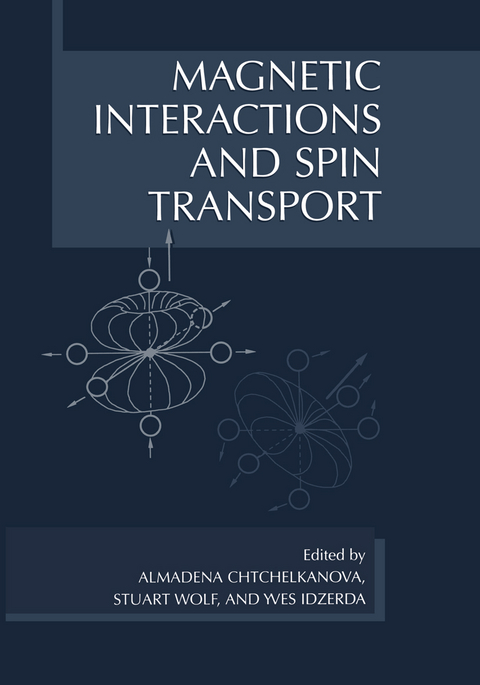
Magnetic Interactions and Spin Transport
Springer-Verlag New York Inc.
978-1-4613-4971-6 (ISBN)
1. Electron Spins in Ionic Molecular Structures.- 1.1. Introduction.- 1.2. Magnetic Cations.- 1.3. Cation Sites in Anion Lattices.- 1.4. Electron Energy Levels in Crystal Fields.- 1.5. Magnetocrystalline Anisotropy.- 1.6. Spin Exchange Between Cations.- 1.7. Spin Ordering in Ferrimagnetic Oxides.- 1.8. Spin Transport in Oxides.- References.- 2. Secondary Magnetic Properties.- 2.1. Introduction.- 2.2. Magneto-Optic Properties.- 2.3. The Kubo Formula.- 2.4. Ab Initio Calculations of the Kerr Effect.- 2.5. Magneto-Crystalline Anisotropy.- 2.6. First-Principle Calculations.- Appendix A.- Appendix B.- References.- 3. Spin-Dependent Transport in Magnetic Multilayers.- 3.1. Introduction.- 3.2. Kubo-Greenwood Formula for Conductivity.- 3.3. Free Electrons with Random Point Scatterers.- 3.4. Boltzmann Equation.- 3.5. Landauer Formula for Conductance.- 3.6. Spin-Dependent Tunneling.- References.- 4. Magnetotransport (Experimental).- 4.1. Introduction and Overview.- 4.2. Electronic Transport in F-Metals and F-Based Alloys.- 4.3. Spin-Dependent Tunneling and “Polarization”.- 4.4. Spin-Injection Studies.- 4.5. Giant Magnetoresistance in F/N Multilayers and Granular Alloys.- 4.6. Granular Magnetoresistance.- 4.7. Tunneling Magnetoresistance.- 4.8. Colossal MR.- 4.9. Miscellaneous Phenomena.- References.- 5. Magnetic Characterization of Materials.- 5.1. Introduction.- 5.2. Units.- 5.3. Magnetic Moment, Magnetization, and Susceptibility.- 5.4. Diamagnetism and Paramagnetism.- 5.5. Magnetic Ordering.- 5.6. Magnetometry.- 5.7. Magnetic Characterizations through Hyperfine Interactions.- 5.8. Concluding Remarks.- 6. Magnetic Domain Imaging of Spintronic Devices.- 6.1. Introduction.- 6.2. Scanning Electron Microscopy with Polarization Analysis.- 6.3. Magnetic Force Microscopy.- 6.4.Magneto-Optic Imaging.- 6.5. Transmission Electron Microscopy.- 6.6. Magnetic Imaging with X-Ray Dichroism.- 6.7. Conclusions.- References.- 7. Domain Dynamics and Magnetic Noise.- 7.1. Introduction.- 7.2. Overview of Magnetic Noise in Device Applications.- 7.3. Magnetic Domains and Magnetization Reversal.- 7.4. Electrical Noise.- 7.5. From Magnetic Fluctuations to Electrical Noise.- 7.6. Stabilization of Magnetic Sensors.- 7.7. Media Noise in Magnetic Recording.- References.- 8. Deposition Techniques for Magnetic Thin Films and Multilayers.- 8.1. Introduction.- 8.2. Thermal Evaporation.- 8.3. Sputtering.- 8.4. Pulsed Laser Deposition.- 8.5. Film Thickness Measurement and Control Techniques.- 8.6. Characterization Techniques.- 8.7. Summary.- References.- 9. Magnetic Sensors.- 9.1. Introduction.- 9.2. Why We Sense Magnetic Fields.- 9.3. Magnetic Sensing Technologies.- 9.4. Spin-Dependent Magnetoresistive Materials.- 9.5. Magnetoresistive Sensor Design.- 9.6. Anisotropic Magnetoresistive Sensors.- 9.7. Giant Magnetoresistive Sensor Design.- 9.8. Spin-Dependent Tunneling Sensor Design.- 9.9. Conclusions.- References.- 10. High Speed Magnetoresistive Memories.- 10.1. Introduction.- 10.2. Memory Fundamentals.- 10.3. Plated Wire and Planar Film Memories, Precursors.- 10.4. Magnetoresistive Memory Design Factors.- 10.5. Honeywell’s Original MRAM.- 10.6. Pseudo Spin Valve, Giant Magnetoresistive Memories.- 10.7. Memories with Spin Valve Materials.- 10.8. Spin Dependent Tunneling Memory Cells.- 10.9. Summary.- References.- 11. Hybrid Devices.- 11.1. Introduction.- 11.2. Hybrid Ferromagnet-Superconducting Devices.- 11.3. Hybrid Ferromagnet-Semiconductor Devices.- References.
| Zusatzinfo | 92 Illustrations, black and white; XXII, 572 p. 92 illus. |
|---|---|
| Verlagsort | New York, NY |
| Sprache | englisch |
| Maße | 178 x 254 mm |
| Themenwelt | Naturwissenschaften ► Physik / Astronomie ► Elektrodynamik |
| Naturwissenschaften ► Physik / Astronomie ► Festkörperphysik | |
| Naturwissenschaften ► Physik / Astronomie ► Theoretische Physik | |
| Naturwissenschaften ► Physik / Astronomie ► Thermodynamik | |
| Technik ► Maschinenbau | |
| Schlagworte | alloy • Crystal • electron microscopy • Magnetic field • Microscopy • semiconductor • Spintronics • Thin film • Transmission Electron Microscopy |
| ISBN-10 | 1-4613-4971-0 / 1461349710 |
| ISBN-13 | 978-1-4613-4971-6 / 9781461349716 |
| Zustand | Neuware |
| Haben Sie eine Frage zum Produkt? |
aus dem Bereich


